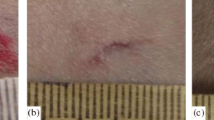Summary
The vascular system in experimental, free, full thickness skin autografts in guinea pigs was visualized by injecting Indian ink in the period between the 6th postoperative day and and eight weeks after the operation. Ideally, revascularization occurs by reactivation ofexisting vessels in the graft. Even reactivation of perifollicular vascular networks and the subepidermal vascular plexus is possible. If revascularization occurs through the growth ofnew vessels, for a long time the vascular arrangement is not the same as that in normal guinea pig skin. The epidermis usually shows acanthosis-like changes. Fast and effective revascularization minimizes the extent and duration of this change.
Zusammenfassung
Beim Meerschweinchen wurde das Gefäßsystem innerhalb experimentell gesetzter autologer freier Vollhauttransplantate durch Tuscheinjektion in einem Zeitraum zwischen dem 6. postoperativen Tag und 8 Wochen nach der Operation dargestellt. Die Revascularisation erfolgt im Idealfall durch Reaktivierung deralten Transplantatgefäße. Selbst eine Reaktivierung der perifollikulären Gefäßnetze und des subepidermalen Gefäßplexus ist möglich. Wenn es zu einer Revaskularisation durch Einwachsenneuer Gefäße kommt, so weicht die Gefäßanordnung über längere Zeiträume erheblich von der normaler Meerschweinchenhaut ab. Die Epidermis ist meist acanthoseähnlich verdickt. Dauer und Ausmaß dieser Veränderung sind um so geringer, je besser und schneller die Revascularisation erfolgt.
Similar content being viewed by others
References
Bellmann, S., Velander, E., Frank, H. A., Lambert, J. B.: Survival of arteries in experimental full thickness skin autografts. Transplantation2, 167–174 (1964).
Birch, J., Brånemark, P. I.: The vascularization of a free full thickness skin graft. I. A vital microscopic study. Scand. J. plast. reconstr. Surg.3, 1–10 (1969).
Birch, J., Brånemark, P. I., Lundskog, J.: The vascularization of a free full thickness skin graft. II. A microangiographic study. Scand. J. plast. reconstr. Surg.3, 11–17 (1969).
Clemmesen, Th.: The early circulation in split skin grafts. Restoration of blood supply to split skin autografts. Acta chir. scand.127, 1–8 (1964).
Clemmesen, Th.: Experimental studies on the healing of free skin autografts. Dan. med. Bull.14, Suppl. 2, 1–74 (1967).
Converse, J. M., Ballantype,: D.L. Distribution of diphosphiridine nucleotide diaphorase in rat skin autografts and homografts. Plast. reconstr. Surg.30, 30, 415–425 (1962).
Conway, H., Stark, R. B., Joslin, D.: Observations on the development of circulation in skin grafts. II. The physiologic pattern of early circulation in autografts. Plast. reconstr. Surg.8, 312–319 (1951).
Davis, J. St., Traut, H. F.: Origin and development of the blood supply of whole thickness skin grafts. Ann. Surg.82, 871–879 (1925).
Erikson, G., Klingenström, P., Nylen, B., Wersäll, J.: Electron microscopic studies on the epidermis in human split skin autografts. Scand. J. plast. reconstr. Surg.2, 83–90 (1968).
Gloor, M., Friederich, H. C.: Experimentelle Untersuchungen zur Durchblutung autologer freier Vollhauttransplantate in der postoperativen Phase am Menschen. Med. Welt (N.F.)21, 967–970 (1970).
Gloor, M., Scharsich, M., Friederich, H. C.: Tierexperimentelle Untersuchungen über den Einfluß des Rasterklebeverfahrens nach Gottlob auf die funktionelle Leistungsfähigkeit und das morphologische Bild freier autologer Vollhauttransplantate. Arch. Derm. Forsch.241, 273–283 (1971).
Gloor, M., Scharsich, M., Friederich, H. C., Steinbach, B.: Über die Bedeutung der Liegezeit des Druckverbandes für das Ergebnis der autologen freien Vollhauttransplantation. Experimentelle Untersuchungen am Meerschweinchen. Derm. Mschr.158, 190–198 (1972).
Gloor, M., Friederich, H. C., Steinbach, B.: Experimentelle Untersuchungen über das Haarwachstum auf freien, autologen Vollhauttransplantaten. 1st Congr. of Oral and Facial Surgery, Dresden 8.5.-13.5. 1972.
Gloor, M., Köhler, J., Klein, P., Friederich, H. C.: Tierexperimentelle Untersuchungen zur Deckung von Hautdefekten mit einem autologen Hauthomogenisat. Chir. plast. (Berl.) (in the press).
Haller, A., Rauenhorst, J., Adkins, J., Billingham, R. F.: Origin of vasculature in skin grafts. Surg. Forum17, 96–97 (1966).
Hinshaw, J. R., Miller, E.R.: Histology of healing split thickness and full thickness autogenous skin grafts and donor sites. Arch. Surg.91, 658–670 (1965).
Hynes, W.: The early circulation in skin grafts with a consideration on method to encourage their survival. Brit. J. plast. Surg.6, 257–265 (1954).
Kadanoff, D., Wassilev, W., Metev, I.: Über die regenerierenden Nervenfasern und Nervenendigungen in Hautnarben und Hauttransplantaten beim Menschen. Anat. Anz.118, 503–514 (1966).
Ljungquist, A., Ålmgard, L. E.: The vascular reaction in the free skin allo- and autografts. A steromicroangiographic and histological study in the rabbit. Acta path. microbiol. scand.68, 553–562 (1968).
Lily, N. R.: Revascularization of a free skin autograft. Acta chir. Acad. Sci. hung.12, 181–192 (1971).
Marckmann, A.: Autologous skin grafts in the rat: Vital microscopic studies of the microcirculation. Angiology17, 475–482 (1966).
Marckmann, A. Biology of skin autografts. Dan. med. Bull.14, 135–137 (1967).
Mir y Mir, L.: Biology of skin graft. New aspects to consider in its revascularization. Plast. reconstr. Surg.8, 378–379 (1951).
Peer, L. A.: Cell survival theory versus replacement theory. Plast. reconstr. Surg.16, 161–168 (1955).
Pihl, B., Weiber, A.: Studies of the vascularization of free full thickness skin grafts with radioisotope techniques. Acta chir. scand.125, 19–31 (1963).
Šmahel, J.: Revaskulace volného kozniho autotransplantátu. Lek. Zbr. lék. Karl. Univ. Suppl. 8, 343–350 (1965).
Šmahel, J.: Problém revaskularizace volného kozniho autotransplantátu. Acta chir. orth. Cech.34, 536–540 (1967).
Šmahel, J.: The revascularization of a free skin autograft. Acta chir. plast. (Praha)9, 76–77 (1967).
Šmahel, J.: The problem of revascularization of free skin autografts. Acta chir. plast. (Praha)11, 78–84 (1969).
Šmahel, J., Ganzoni, N.: Contribution to the origin of vasculature in free skin autografts. Brit. J. plast. Surg.23, 322–325 (1970).
Steigleder, G. K., Gans, O.: Pathologische Reaktionen in der Epidermis. In: Handbuch der Haut- und Geschlechtskrankheiten. By J. Jadassohn, Suppl. Vol. 1, Part 2, pp. 178–246. Berlin-Göttingen-Heidelberg-New York: Springer 1964.
Taylor, A. C., Lehrfeld, J. W.: Determination of survival time of skin homografts by observation of the vascular changes in the graft. Plast. reconstr. Surg.12, 423–431 (1953).
Tiedemann, H.: Über die Gefäßversorgung von Haut- und Lebertransplantaten. Virchows Arch. path. Anat.317, 461–483 (1949).
Wolff, K., Schellander, F.: Zur Encymhistochemie des Heilungsprozesses von Spalthauttransplantaten. Wien. klin. Wschr.77, 509–510 (1965).
Zarem, H. A., Zweifach, B. W., McGehee, J. M.: Development of microcirculation in full thickness autogenous skin grafts in mice. Amer. J. Physiol.212, 1081–1085 (1967).
Author information
Authors and Affiliations
Rights and permissions
About this article
Cite this article
Gloor, M., Ludwig, G. Revascularization of free full thickness skin autografts. Arch. Derm. Forsch. 246, 211–221 (1973). https://doi.org/10.1007/BF00595421
Received:
Issue Date:
DOI: https://doi.org/10.1007/BF00595421




